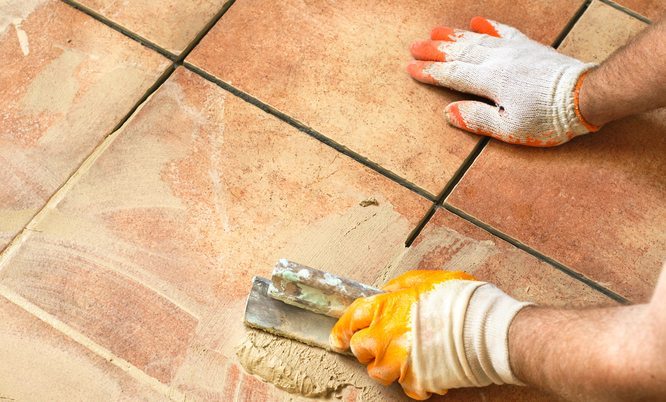When It Comes to Grout You Have Options

In many ways, grout is the unsung hero of every tile installation. Not only does it keep the tiles fixed in their place, but it also prevents water penetration and protects the tile from chipping and cracking around the edges. While grout often goes overlooked, any professional tiling specialist will tell you that you should give just as much thought to grout selection as you do to tile selection.
Fortunately, modern technology has afforded us a wide range of grout options to choose from, with a virtually unlimited array of colors to harmonize or contrast with your tiles. If you’ve been looking for the right grout for your tiling project, below are some key points and tips to help you weigh out your options.
Types of Grout
There are two basic types of grout: sanded and unsanded. Unsanded grout is a pudding-like mixture comprised of Portlant cement, water, and powdered pigments, while sanded grout is basically the same thing but with sand added to the mix. Interestingly enough, the way that you determine which type of grout to choose has more to do with the space between the tiles than the tiles themselves.
If your tiling project calls for small joints between the tiles (typically 1/8 of an inch or less), then unsanded grout is the way to go. Sanded grout, on the other hand, should be used for joints that are more than 1/8 of an inch in width, because the added sand helps thicken the mixture enough to prevent shrinkage between the tiles. Whether you choose sanded or unsanded grout, keep in mind at all cement-based grouts are porous and therefore vulnerable to staining. For this reason, it’s a good idea to apply a grout sealer after the grout has had a chance to cure and completely dry.
In addition to cement-based grouts, you can also consider epoxy grout, which is comprised of resin and hardener and is generally considered to be much more resistant to stains and chemicals. Epoxy grout is available in sanded and unsanded varieties as well and is a top choice for highly trafficked areas that endure quite a bit of wear and tear (e.g., floors, backsplashes, kitchen counters, etc.).
Choosing the Right Grout Color
Deciding on the right color for your grout will largely depend upon the type of look you’re trying to achieve. In terms of aesthetics, most tiling installations will fall into one of the following three categories: Contrasting, harmonizing or neutral.
- Contrasting grout (e.g., white grout between black tiles) is often used as a way to highlight the layout or design pattern of the tile itself. If your tiling project features a visually interesting arrangement for the tiles (e.g., herringbone, vertical offset, chevron, etc.), choosing a contrasting grout color will really give emphasis to these patterns and shapes.
- Harmonizing grout (e.g., green grout between green tiles) places more emphasis on the tile itself, allowing the tile to “showcase” its important visual features such as color, veining, tonal inflections, etc. In addition, using a grout color that harmonizes with the base color of the tile is a great way to add a greater sense of space to a smaller room, as there are no visual interruptions that can draw the eye away from viewing the space as an integrated whole.
- Neutral grout (e.g., shades of gray or white) is almost always a safe bet, which makes it a very versatile choice for a wide range of tile colors and styles. One of the most popular trends in tile work today is to use a neutral gray grout with white subway tiles, as it lends a contemporary look to a classic design.
Summing It All Up
No matter which grout you choose, it’s always a good idea to create a “test section” of tile on a piece of plywood using the grout of your choice. Try viewing this test section under various light sources (e.g., natural, fluorescent, incandescent, etc.) to see how the colors respond; this will help you arrive at your final choice.
For the best results, consider contacting the tiling experts at McSwain Carpets & Floors. Our team has years of experience in working with a wide variety of tile and grout types, and we will help you narrow down your options so that you can pick the right grout to suit the needs of your specific project. Give us a call or visit one of our locations today to get started!
